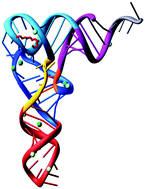tRNA – the golden standard in molecular biology†
Abstract
Transfer RNAs (tRNAs) represent a major class of RNA molecules. Their primary function is to help decode a messenger RNA (mRNA) sequence in order to synthesize protein and thus ensures the precise translation of genetic information that is imprinted in DNA. The discovery of tRNA in the late 1950's provided critical insight into a genetic machinery when little was known about the central dogma of molecular biology. In 1965, Robert Holley determined the first nucleotide sequence of alanine transfer RNA (tRNAAla) which earned him the 1968 Nobel Prize in Physiology or Medicine. Today, tRNA is one of the best described and characterized biological molecules. Here we review some of the key historical events in tRNA research which led to breakthrough discoveries and new developments in molecular biology.

- This article is part of the themed collection: Chemical Biology in Molecular BioSystems

 Please wait while we load your content...
Please wait while we load your content...